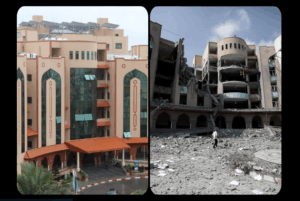‘Serving the community’: Life at the Islamic University of Gaza before the war

The Islamic University of Gaza – before the 2023-25 war and since its destruction
Enrico Di Gregorio writes in The Palestine Chronicle on 3 November 2025:
Right in the center of Gaza City, a building with sand-colored walls and caramel-colored columns and roofs and mirrored blue windows housed the Islamic University of Gaza (IUG). About 17,000 students – 62 percent of them women and many with physical, visual, or hearing disabilities – attended classes, studied in the central library, and developed projects in more than 200 science laboratories and 75 computer rooms.
This description is part of the memory of Dr. Amani Ahmed Al-Mqadma, head of the IUG’s International Relations Office, who told the Palestine Chronicle and the A Nova Democracia newspaper, by email, what the institution was like before the Israeli bombings that totally or partially destroyed all 16 buildings on the University’s central campus. “It was a beautiful building, standing proudly among large green areas.”
IUG was founded in 1978 as an independent academic institution, supervised by the Ministry of Higher Education. “Today, it has 20 research centers and offers 169 academic programs and 11 faculties: medicine, engineering, information technology, health sciences, sciences, arts, education, nursing, administration, Shari’a and law, and Islamic studies,” explains Al-Mqadma. Approximately 90,800 students have graduated from the college since its founding.
“Engineering is one of the University’s most prominent fields. The college began offering training in civil engineering and architecture in 1992 and 1993 and, today, has departments of electrical, computer, mechanical, environmental, and artificial intelligence engineering.” For Al-Mqadma, one of the most prominent projects was the Wave Energy Station, developed by the Center of Excellence for Renewable Energy. With international partnerships, IUG engineers built a structure on the Gaza coast capable of converting wave motion into energy.
The station is a modest power plant installed in one of Gaza’s ports. There, four metal arms welded by Gaza engineers connect to red structures that resemble little ship noses. As the waves crash, the metal structure moves, generating kinetic energy that is converted by the rest of the machinery, generating up to 10 kilowatts. “This will potentially be implemented even into a bigger station at different locations, both locally and globally, in the future”, says the website of the project.
